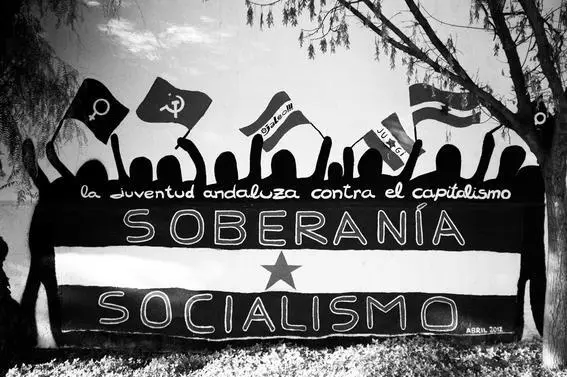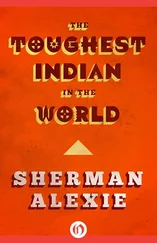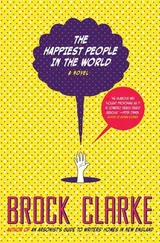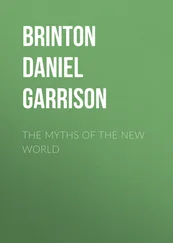‘The bandoleros would probably still be there, too – but it’s so fucking cold, they had to come down the mountain and get jobs in Congress.’
Spanish hills are usually concealing something, even if they have sometimes been sites of salvation: havens for rebel peasant leaders hiding from persecution, and for the Spanish maquis , the partisan guerrillas who didn’t give up on the dream, even after the fascists won the Civil War in 1939, and fought on against Franco. The partisans are the people’s heroes depicted in the Oscar-winning film Pan’s Labyrinth , a ragtag army refusing to be cowed by the greater power intent on destroying them, deployed in the three branches of the Spanish State: the military, the Church and the government.
Like the bandits, anarchists in hiding from the authorities took cover in the Andalusian hills – sometimes for years on end, avoiding arrest and execution by the Guardia Civil. In fact, the different outlaws helped each other: the bandits concealed in the hill towns and the mountains made it easier for revolutionaries and fugitives, as well as cloth and tobacco smugglers, to move their intellectual or commercial wares in secrecy, sneaking on foot over narrow mountain ridges to the next town.
When itinerant evangelical preachers were spreading anarchism through the countryside in the late nineteenth century, it was known simply and magnificently as ‘the idea’. The Andalusian river valleys became its conduits, carrying newspapers, people and ‘the idea’ from town to town – a red and black river through the blanched, dusty fields. It travelled with astonishing speed in Spain, ‘carried from one village to the next by Anarchist “apostles’ ”, writes Brenan in The Spanish Labyrinth . They travelled light and cheap, ‘like tramps or ambulant bullfighters under the tarpaulins of goods wagons’, and received no pay or retainer, instead living ‘like mendicant friars on the hospitality of the more prosperous work-men’. Anarchists were poor: Bakunin himself couldn’t afford the train fare to Barcelona for the inaugural congress of his own branch of the International, but his lieutenants made up for their impecuniousness with fervour. The campaign was kept alive through newspapers such as El Socialismo and El Productor , often sold via the barber. El Productor even had local agricultural correspondents in the south, to report on the increasingly violent uprisings in the region.
Fermín Salvochea, known as the ‘saint’ of Spanish anarchism, edited some of these papers, including El Socialismo , which helped bring Kropotkin’s ideas to the peasants of the south. A nineteenth-century Sánchez Gordillo, he later became an icon for the marinaleños . When he wasn’t busy being in jail or leading armed uprisings against the Spanish state, he served as mayor of Cadiz, in the late nineteenth century; even before universal suffrage, it was possible to get to the top in Andalusian local government while opposing the idea of hierarchical power. Fifty thousand people attended his funeral in 1907, an event worthy of the beatification of a more religious kind of saint. There is, of course, a street named after him in Marinaleda.
More often than not, the struggles of the valiant sons and daughters of Andalusian workers’ rebellion resulted in failure. The repeated uprisings were crushed, thanks to the landowners’ military henchmen in the Guardia Civil. In 1884 seven peasants were executed in Jerez de la Frontera – 100 miles south-west of Marinaleda – for their alleged involvement in a secret group called La Mano Negra , The Black Hand, the infamous anarchist terrorist organisation whose existence may or may not have been entirely invented by the state. La Mano Negra had been blamed for a series of murders and acts of arson in the preceding years. As a result, whether the allegations were fictional or not, the anarchist press was banned and some of its leading lights forced into hiding.
The mythology stuck around. ‘The shadow of La Mano Negra , the secret and righteous brotherhood of the last century, looms over the plazas of Andalusia’s villages and runs through its farms’, began an article in the generally sane national newspaper El País in 1981. The ostensible subject of the article, beyond reviving the far-left bogeymen of a century before, was the burgeoning activities of Sánchez Gordillo’s field-workers’ union, the SOC. Sensationalism aside, El País was at least correct to acknowledge the ‘common tradition’, and that Andalusian jornaleros ‘have not forgotten what constitutes their past, nor what they experienced, nor what has been handed down from father to son’. And what were they doing with that shared history of starvation, brutality, torture and repression? Working on revenge.

3
La Lucha
We want peace. The people always wanted peace. But be clear that we do not want the peace of the last forty years of gazpacho, lice and cortijos,{A cortijo is a prosperous farm, grange or ranch, its compound often enclosed by a wall.} or all that which is preached by the Pharisees of the old established disorder.
Juan Manuel Sánchez Gordillo, ‘Hunger and Peace’,
El País , 1982
We arrived at El Humoso and parked the car. It was a mild, misty January day, the sunlight gleaming through the hanging mist. The air tasted as clean as water, and the only sounds disrupting this rural idyll were the odd rooster in the background and a dog barking at nothing in particular. On one side of the car park was a large olive oil processing factory, on the other a freshly painted white farm administration building, adorned with a red roof, its windowsills and columns picked out in green. It looked like a mansion house from America’s old South, détourné by its paint job in the Marinaleda colour scheme. To the side stood large greenhouses for tomatoes, spinach and lettuces, supplementary crops to be sold in the town’s grocery shops. The entrance to the fields was marked by a giant single-wall facade plastered with two substantial political murals.
‘ Este cortijo es para los jornaleros en paro de Marinaleda ’ (this farm is for the unemployed labourers of Marinaleda) was written in massive capital letters along one stretch of wall, punctuated with a painting of the village’s iconic tricolour flag. On the other side was a giant socialist-realist painting of two fifteen-foot tall jornaleros emerging proudly, tired, from their work in the fields, with TIERRA UTOPIA written underneath.
A family lives on the El Humoso farm as caretakers, running the day-to-day operations; but they are neither bosses nor owners – this is a co-operative, my guide stressed. This is the co-operative, in fact: the symbolic and actual cornerstone of Marinaleda’s utopian achievement – a 1,200-hectare farm won through thirteen years of relentless struggle. In 1991 the land was expropriated from the Duke of Infantado (in exchange for an undisclosed sum in compensation) and awarded by the Andalusian regional government to the people of Marinaleda.
We walked over to the farm’s olive oil processing plant, where four or five men in blue overalls were operating the machinery. The olives are stripped from any twigs by the first machines, then cleaned by blasts of water, then smashed into pulp. From this mash the gooey oil is siphoned off, then filtered, and filtered again. The collective produces 300,000 litres of olive oil a year. Scattered around the gleaming pipes and machinery were boxes stamped with the Marinaleda Cortijo El Humoso logo, in red, white and green, and a stamp of the same tierra utopia painting from the farm.
Читать дальше













